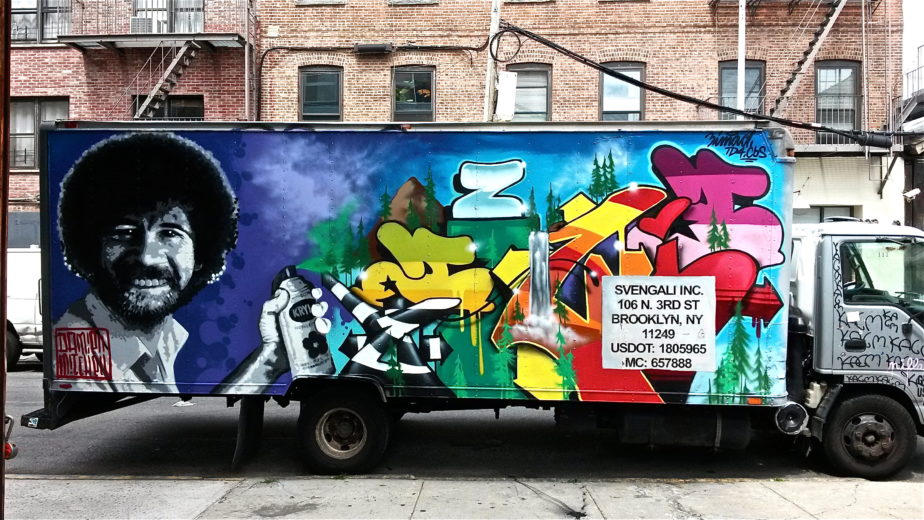Whenever I go to a graffiti show with my dad, most of the time it’s in an art gallery where the finished pieces are hanging on walls to be viewed and purchased. Yet, graffiti wasn’t always viewed as an art form. In the 1970’s it was considered an act of vandalism and a crime. Many viewed it as merely street art, something you would see in the ghettos of New York City. Graffiti would however, evolve from being ‘taboo’ to being, not just socially acceptable, but now a form of pop art. What many don’t realize is that this art form has a long and storied history, one that would leave a mark on not only the art, but also the artists.
Origins of the Art
If you think graffiti is a recent trend or its origins limited to NYC. Think again. Graffiti has always been around. From the ancient Greeks and Romans carving messages on walls to gangs using it as a way to mark their territory, to people using it as a way to remember those who died. Which coincidentally happened to be New York City’s first taste of graffiti. You see, in 1955, jazz legend Charlie “Yardbird” Parker died; and shortly after his death, “Bird Lives” tags began to pop up on the streets of New York City.
However, the Bird tags didn’t stick around and the trend died down. Fast forward 20 years later to a Washington Heights foot messenger who would write his nickname wherever he went. This foot messenger turned out to be TAKI 183, who along with many other writers/artists, became one of the pioneers of the New York City graffiti scene. What soon followed after TAKI 183 was a graffiti takeover. Tagging your name on the street became a badge of honor and soon moved to the subway system. What started as simply writing your name on a train turned to tagging the side of trains. Which evolved into a competition to see who could create the biggest and greatest piece.
Origins of the Artists
In addition to the art that was being created, there were artists being formed. Luis “Zimad” Lamboy and Byron “Crase” Marquez are prime examples. As they bore witness to and were an integral part of creating the movement.
Luis Lamboy, also known as Zimad, has been doing graffiti for over 38 years. Starting at just 14 years-old, Lamboy says that growing up in the Melrose Projects, seeing the graffiti in the stairway left a mark on him and in a way urged him to do the same.
“I got to liking what I was seeing. Other friends that were writing for a couple years before me would give me pointers on what I was doing.” Not too long after, Lamboy joined the Bronx Artist Crew and expanded from tagging to bigger items such as throw ups and pieces. “I think I got involved because it actually started getting me popular,” Lamboy says. “I liked the feeling of being bad.”
Not unlike folks that go in for tattoo ink, Lamboy says that graffiti became addictive. Once you got the taste for it, you couldn’t stop. The rush of getting away with expressing yourself through graffiti, illegally, made it hard to stop. Since 1985, Lamboy went from street graffiti to doing canvases for group shows at the local gallery. The old Fashion Moda in the Bronx happened to be that gallery. Those Fashion Moda shows opened up more opportunities for Lamboy. He got to travel the world and do more group shows.
Today Lamboy has traded subway trains and brick walls, for canvass and galleries. Lamboy currently does around eight to ten shows a year. “It’s nothing like having a show in a gallery,” says Lamboy. “People that show up to show love and support are there for me. I feel like a star for that night.”
Another graffiti pioneer, is Guatemalan born, Byron “Crase” Marquez who like Lamboy was just a teen when he started. “In 1980 I was going to school in Queens and as I was going to school, I met this kid that wrote his name,” said Marquez. “But I already started to notice it on the trains and on the buses, and on the streets. The first writings I saw were FTD 56, Clyde, Stay High 149, and Iz.”
Marquez remembers seeing the opening credits of the show Welcome Back Kotter and noticing the graffiti from Iz the Wiz. After that, Marquez saw a news special that featured other graffiti artists such as Crash, Daze, and Futura. “I remembered Crash because I saw his name on the trains,” said Marquez. It wasn’t until he saw his friend from high school tagging. The high school friend turned out to be Craze. Marquez thought it was cool and decided that he wanted to take part. Only one problem though; he didn’t have a name. It wasn’t until Craze recommended that Marquez use the name Crase with an “S” instead of a “Z”. Craze taught Marquez the ropes and the two would mostly street bomb.
“He was like my partner you can say,” Marquez says about the partnership formed between him and Craze. However, what really made Marquez step it up with his graffiti was seeing two artists do a throw up in front of him. “That’s what really turned on the lights,” said Marquez. “After that I started doing it every day and I wanted to do it every day.” As a result of this intense focus on graffiti more than school, Marquez was shipped off to Los Angeles by his parents, as a means to get him away from the graffiti scene; but what Marquez and his parents didn’t know was that he was heading right into a perfect opportunity.
One of the most rewarding moments in Marquez career as a graffiti artist was working on the film Breakin’. “It was an experience, not something I planned or looked for,” Marquez says with pride. “It was a beautiful experience where I was able to [ ] do something that I enjoyed a lot.”
The opportunity came after Marquez moved to California, he was invited by friends from the Shake City Rockers Crew, which Marquez was also a member of, to hang out at the legendary Radiotron, a place where B-Boys, graffiti artists, and DJ’s hung their hats. It was there that he would meet rapper Ice-T. “I was introduced to Ice-T. I spoke to him. He heard that I was into graffiti and that I was pretty good,” said Marquez. “He informed me about the audition (for Breakin’). He told me to be there at 3:30 and that he’ll introduce me to the people doing the casting call.”
Of course, he went. It would be crazy to pass up an opportunity like that. “After school, I went to the audition. Once I arrived, Ice-T introduced me to the people. They asked if I could do a piece on an 8×10 plywood canvas,” Marquez said, remembering the audition process. “I did and they liked it. A week later, I got the call that I got it. To be part of that movie was a big accomplishment.”
The Future
As you walk through New York City today, you may still see some remnants of graffiti but it’s not as prevalent as it was in the 70’s and 80’s. Although graffiti may have died down on the streets, it’s just getting started in cyberspace.
“Graffiti in the future will only get better,” says Lamboy. “The next generation of writers will have at their disposal, new tools to create their masterpieces.” Besides the advancement of traditional tools such as spray paints and inks, the newest and most important tool happens to be social media. “The help of the internet, [allows you] to see what is going on across the globe,” Lamboy said. “I never thought this was possible back in the day.” Marquez agrees. “You have Facebook, you have social media,” Marquez said. “Social media is going to help you more than it has in the past.”
With artists now able to post and share their work online for the entire world to admire and increase awareness, the art form is no longer bound by the concrete of the streets or metal of a subway car. And the pioneers welcome that with open arms.

